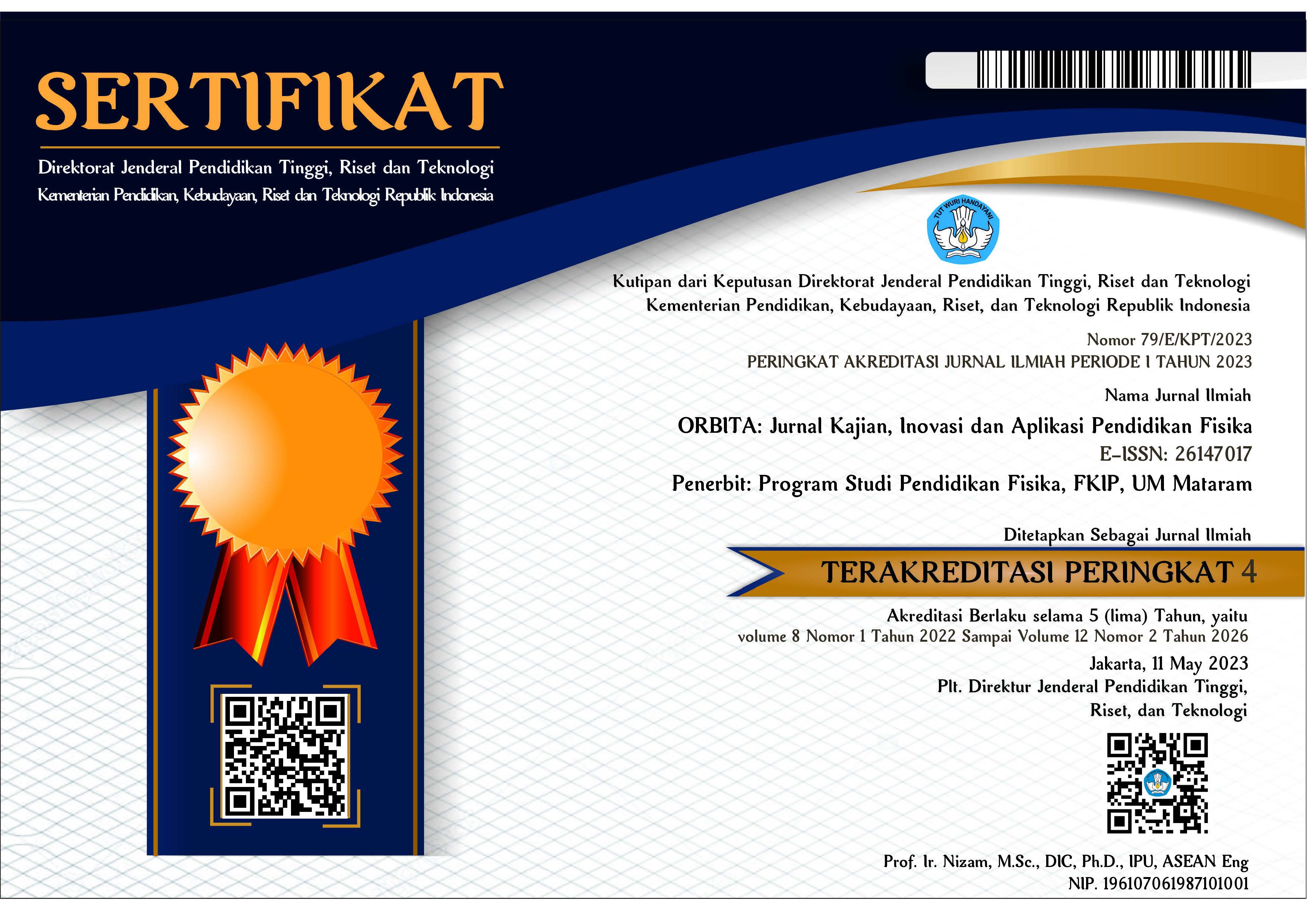Analysis of the relationship between learning styles and creativity with high school physics learning outcomes
Abstract
Difficulties experienced by students in learning Physics include both students and teachers not being able to recognize their learning styles and students' lack of creativity in learning which will have an impact on learning outcomes. The aim of this research is to analyze whether there is a relationship between learning style and creativity with high school physics learning outcomes. This type of research is descriptive research with a correlational quantitative approach. The research population is State High Schools in Payakumbuh. Sample selection applies Purposive Cluster Sampling by selecting 1 from each school ranking, high, medium and low. The instruments used are the learning style questionnaire consisting of 26 items and the creativity questionnaire consisting of 27 items. The data analysis technique uses prerequisite analysis tests, namely the normality test; homogeneity test and hypothesis test using linearity test, multiple linear regression test and correlation test. The results obtained are as follows: (1) there is a positive relationship between learning style and learning outcomes. (2) there is a positive relationship between creativity and learning outcomes at a significance level of 5% or 0.05.
Keywords
Full Text:
PDFReferences
Adawiyah, T. ., Harso, A., & Nassar, A. (2020). Hasil Belajar IPA Berdasarkan Gaya Belajar Siswa. Science, and Physics Education Journal (SPEJ), 4(1), 1–8. https://doi.org/https://doi.org/10.31539/spej.v4i1.1636
Amin, M. (2019). Pengaruh Pendekatan Pembelajaran Saintifik terhadap Kreativitas Belajar Siswa. Dirasah : Jurnal Studi Ilmu Dan Manajemen Pendidikan Islam. 2(1), 63–74. https://doi.org/https://doi.org/10.29062/dirasah.v2i1.36
Arylien, L. B., Uda, G., & B, J. (2019). Pengaruh Gaya Belajar Visual, Auditorial, Dan Kinestetik Terhada Prestasi Belajar Siswa. Jurnal Review Pendidikan Dan Pengajaran, 2(2), 291–296. https://doi.org/https://doi.org/10.31004/jrpp.v2i2.486
Lestari, I. (2015). Pengaruh Waktu Belajar dan Minat Belajar terhadap Hasil Belajar Matematika. Formatif: Jurnal Ilmiah Pendidikan MIPA, 3(2), 115–125. https://doi.org/https://doi.org/10.30998/formatif.v3i2.118
Mandasari, Y., & Nadjamuddin, N. (2015). Pengaruh Gaya Belajar Siswa Terhadap Kreativitas Siswa Pada Mata Pelajaran Seni Budaya Dan Keterampilan (SBK) Materi Seni Rupa Menggambar Kelas 4 Di Madrasah Ibtidaiyah Darul Ulum Karang Binangun Belitang Oku Timur. JIP Jurnal Ilmiah PGMI, 1(1), 58–79. https://doi.org/https://doi.org/10.19109/jip.v1i1.517
Nurlia, N., Hala, Y., Muchtar, R., Jumadi, O., & Taiyeb, M. (2017). Hubungan Antara Gaya Belajar, Kemandirian Belajar, dan Minat Belajar dengan Hasil Belajar Biologi Siswa. Jurnal Pendidikan Biologi, 6(2), 321–328. https://doi.org/10.24114/jpb.v6i2.6552
Sari, N., Sunarno, W., & Sarwanto, S. (2018). Analisis Motivasi Belajar Siswa Dalam Pembelajaran Fisika Sekolah Menengah Atas. Jurnal Pendidikan Dan Kebudayaan, 3(1), 17–32. https://doi.org/10.24832/jpnk.v3i1.591
Setyowati, D., & Widana, I. W. (2016). Pengaruh minat, kepercayaan diri, dan kreativitas belajar terhadap hasil belajar matematika. Jurnal Emasains, V(1), 66–72.
Sugiyono. (2017). Statistika untuk Penelitian (29th ed.). CV ALFABETA.
Suparwoto. (2007). Dasar-dasar dan proses pembelajaran fisika. Fakultas MIPA UNY.
Suriansyah, A. (2011). Landasan Pendidikan. In 2011. http://idr.uin-antasari.ac.id/6633/1/Buku Landasan Pendidikan.pdf
Suyonoo, A. (2018). Pengaruh Gaya Belajar Terhadap Hasil Belajar Pada Mata Pelajaran Akuntansi Kelas XI IPS SMA N 3 Tapung Tahun Ajaran 2017/2018. Jurnal Pendidikan Ekonomi Akuntansi, 6(1), 1–10. https://doi.org/https://journal.uir.ac.id/index.php/Peka/article/view/1858
Triumiana, A. D., & Sumadi. (2016). Hubungan Antara Gaya mengajar Guru, Motivasi Belajar Siswa dan Kreatifitas Belajar Siswa dengan Prestasi Belajar Fisika. Jurnal Ilmiah Pendidikan Fisika-Compton, 3(2), 56–64.
Unaifah, F., & Suprapto, N. (2014). Profil Kemampuan Pemecahan Masalah dan Hasil Belajar Siswa pada Materi Elastisitas Ditinjau dari Gaya Belajar (Learning Style). Inovasi Pendidikan Fisika, 3(2), 27–32.
Wardhany, R. P. K. (2014). Media Video Kejadian Fisika Dalam Pembelajaran Fisika Di SMA. Jurnal Pembelajaran Fisika, 1–8.
Wijayanto, A. (2008). Analisis Korelasi Product Moment Pearson.
DOI: https://doi.org/10.31764/orbita.v10i1.20063
Refbacks
- There are currently no refbacks.

This work is licensed under a Creative Commons Attribution-ShareAlike 4.0 International License.
______________________________________________________
ORBITA: Jurnal Pendidikan dan Ilmu Fisika
p-ISSN 2460-9587 || e-ISSN 2614-7017
This work is licensed under a Creative Commons Attribution-ShareAlike 4.0 International License.
EDITORIAL OFFICE:


























